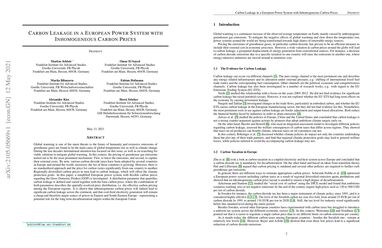Carbon Leakage in a European Power System with Inhomogeneous Carbon Prices
Global warming is one of the main threats to the future of humanity and extensive emissions of greenhouse gases are found to be the main cause of global temperature rise as well as climate change. During the last decades international attention has focused on this issue, as well as on searching for viable solutions to mitigate global warming. In this context, the pricing of greenhouse gas emissions turned out to be the most prominent mechanism: First, to lower the emissions, and second, to capture their external costs. By now, various carbon dioxide taxes have been adopted by several countries in Europe and around the world; moreover, the list of these countries is growing. However, there is no standardized approach and the price for carbon varies significantly from one country to another. Regionally diversified carbon prices in turn lead to carbon leakage, which will offset the climate protection goals. In this paper, a simplified European power system with flexible carbon prices regarding the Gross Domestic Product (GDP) is investigated. A distribution parameter that quantifies carbon leakage is defined and varied together with the base carbon price, where the combination of both parameters describes the spatially resolved price distribution, i.e. the effective carbon pricing among the European regions. It is shown that inhomogeneous carbon prices will indeed lead to significant carbon leakage across the continent, and that coal-fired electricity generation will remain a cheap and therefore major source of power in Eastern and South-Eastern Europe - representing a potential risk for the long term decarbonization targets within the European Union.
PDF Abstract